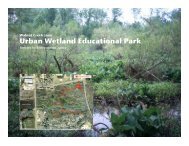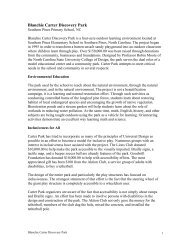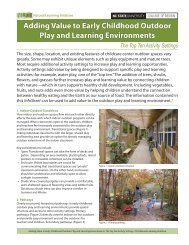LATIS Forum on Therapeutic Gardens - Natural Learning Initiative
LATIS Forum on Therapeutic Gardens - Natural Learning Initiative
LATIS Forum on Therapeutic Gardens - Natural Learning Initiative
Create successful ePaper yourself
Turn your PDF publications into a flip-book with our unique Google optimized e-Paper software.
Provide a range of appropriately scaled, accessible multipurpose settings for hands-<strong>on</strong> activities as wellas for social gatherings.When a garden supports an active program, spaces for group activities with the therapist or play leadermust be provided. The design of these settings must be fully discussed with the relevant staff with regardto locati<strong>on</strong>, size, flexibility (fixed or movable furniture), and seas<strong>on</strong>al variati<strong>on</strong>s. Where possible, activitysettings should be designed to also serve social functi<strong>on</strong>s. Suitable ground surfaces include lawn (forcomfort and flexibility of use) and paving (for accessibility). A mix of both soft and hard surfaces usuallyoffers maximum flexibility of use.Figure 16. This shallow, raised sandtableextends the main sand play setting to allow awheelchair user (adult or child) to be includedin the group activity. (Photo: Robin Moore)15. Integrating the ArtsProvide opportunities for artists to c<strong>on</strong>tribute to both the design and the programming of the garden.Inclusi<strong>on</strong> of artists <strong>on</strong> the design team and the integrati<strong>on</strong> oftemporary and permanent works of art into the garden will addaesthetic richness and symbolic meaning to the garden.C<strong>on</strong>sider designing gardens to explicitly attract communityartists, playworkers, and animators desiring to c<strong>on</strong>tribute or to behired to work with children (Moore & W<strong>on</strong>g, 1997, Chapter 14).Most important of all, children should be able to execute theirown art projects (including garden designs) and display them inthe garden.<strong>Therapeutic</strong> gardens offer innumerable opportunities forintegrati<strong>on</strong> of the arts. The reflective tile surface at the base ofthe tree shown at right (Figure 17) stimulates children to enjoythe multiplied movement of the branches and flowers during theblooming seas<strong>on</strong>. The effect is mesmerizing, as children feelsuspended between the tree crown and reflected image.47Figure 17. Reflective tile at the base ofa tree (Photo Nilda Costco)






